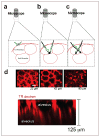The spatiotemporal cellular dynamics of lung immunity
- PMID: 24974157
- PMCID: PMC4124173
- DOI: 10.1016/j.it.2014.05.005
The spatiotemporal cellular dynamics of lung immunity
Abstract
The lung is a complex structure that is interdigitated with immune cells. Understanding the 4D process of normal and defective lung function and immunity has been a centuries-old problem. Challenges intrinsic to the lung have limited adequate microscopic evaluation of its cellular dynamics in real time, until recently. Because of emerging technologies, we now recognize alveolar-to-airway transport of inhaled antigen. We understand the nature of neutrophil entry during lung injury and are learning more about cellular interactions during inflammatory states. Insights are also accumulating in lung development and the metastatic niche of the lung. Here we assess the developing technology of lung imaging, its merits for studies of pathophysiology and areas where further advances are needed.
Copyright © 2014 Elsevier Ltd. All rights reserved.
Figures




References
-
- Olkon DM, Joannides M. Capillaroscopic Appearance of the Pulmonary Alveoli in the Living Dog. The Anatomical Record 1930;45
-
- Wearn JT, et al. The normal behavior of the pulmonary blood vessels wiht observations on the intermittence of the flow of blood in the arterioles and capillaries. American Journal of Physiology 1934;109
-
- Terry RJ. A THORACIC WINDOW FOR OBSERVATION OF THE LUNG IN A LIVING ANIMAL. Science. 1939;90:43–44. - PubMed
-
- Wagner WW. Pulmonary microcirculatory observations in vivo under physiological conditions. J Appl Physiol. 1969;26:375–377. - PubMed
Publication types
MeSH terms
Grants and funding
LinkOut - more resources
Full Text Sources
Other Literature Sources
Medical

